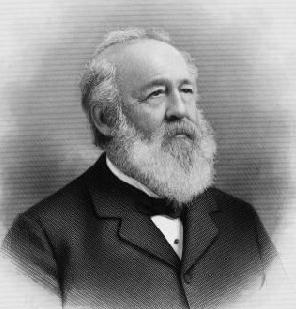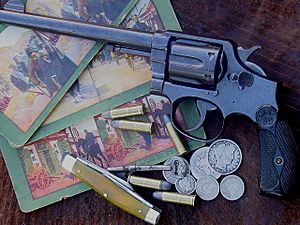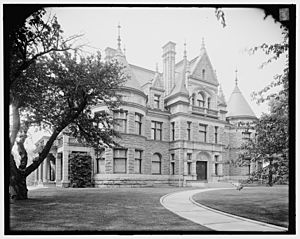Daniel B. Wesson facts for kids
Quick facts for kids
Daniel B. Wesson
|
|
|---|---|
 |
|
| Born | May 18, 1825 |
| Died | August 4, 1906 (aged 81) |
| Occupation | Inventor, industrialist |
| Known for | Co-founder of Smith & Wesson with Horace Smith |
| Spouse(s) | Cynthia Maria Hawes |
| Children | Sarah Jeannette Wesson Bull, Walter Wesson, Frank Wesson, and Joseph Wesson |
| Relatives | Daniel Baird Wesson II, Edwin Wesson, Frank Wesson |
Daniel Baird Wesson (born May 18, 1825 – died August 4, 1906) was an American inventor and designer of firearms. He helped create many important gun designs during his life. He and Horace Smith started two companies called "Smith & Wesson." The first company later became the Winchester Repeating Arms Company. The second company is the well-known Smith & Wesson we know today.
Contents
Who Was Daniel B. Wesson?
Daniel Baird Wesson was born in Worcester, Massachusetts. His parents were Rufus and Betsey Wesson. Daniel's father was a farmer who made wooden plows. Daniel worked on the family farm and went to public school. When he was eighteen, he started learning from his brother, Edwin Wesson. Edwin was a famous maker of target rifles and pistols in the 1840s.
Daniel Wesson's Family Life
Daniel Wesson married Cynthia Maria Hawes on May 26, 1847. Her father was worried that Daniel, being a "gunsmith," had no future. Because of this, Daniel and Cynthia had to elope, meaning they ran away to get married. By 1865, Wesson was earning a lot of money, over $160,000 a year, from Smith & Wesson.
Daniel and Cynthia had four children: one daughter and three sons. Their children were Sarah Jeannette, Walter Herbert, Frank Luther, and Joseph Hawes. Sadly, Frank died in a train accident. Walter and Joseph later became important leaders at the Smith & Wesson company.
Starting Smith & Wesson
In 1854, Daniel B. Wesson teamed up with Horace Smith and Courtlandt Palmer. They worked together to create a new type of lever-action pistol. They also made the first repeating rifle, which was called the Volcanic. These guns were made in Horace Smith's workshop in Norwich, Connecticut.
The First Smith & Wesson Company
At first, their company was called "Smith & Wesson Company." But in 1855, they changed the name to "Volcanic Repeating Arms Company." This happened because new investors joined, including Oliver Winchester. The Volcanic Repeating Arms Company took over all the rights to the Volcanic gun designs. This included both the rifle and pistol versions, as well as the special ammunition they used.
Wesson stayed on as the plant manager for eight months. Then, he left to join Horace Smith again. They started a new company called the "Smith & Wesson Revolver Company." They did this after getting a special license for a "rear loading cylinder" patent from Rollin White. This patent was very important for making new kinds of revolvers.
Innovations in Firearms
In 1856, Smith & Wesson began making a small revolver. This gun was designed to shoot a special type of bullet called a rimfire cartridge. They had patented this cartridge in August 1854. This new revolver was the first successful gun in the world that could load its own cartridges.
Smith & Wesson made sure they had patents for their revolver. This stopped other gun makers from creating similar cartridge revolvers. This gave the young company a very successful business.
Later Years of the Company
When Horace Smith was 65, he decided to retire. He sold his part of the business to Wesson. This made Daniel Wesson the only owner of the company. In the late 1800s, the company started making revolvers without a hammer, called hammerless revolvers. This style is still made today.
In 1899, Smith & Wesson introduced a very famous revolver. It was called the .38 Military & Police. Later, in 1957, its name was changed to the Model 10. This revolver has been made continuously since 1899. It has been used by almost every police department and military group around the world.
Daniel Wesson's Lasting Impact
Daniel Wesson continued to be active in his company until he passed away. He died at his home in Springfield, Massachusetts, on August 4, 1906. He had been sick for four years. His wife, Cynthia, had passed away just a month before him. The Wessons are buried in Oak Grove Cemetery in Springfield.
Helping the Community
Wesson strongly believed in homeopathy, a type of medicine. In 1904, he gave $100,000 to build a new hospital building in Springfield. This hospital was for the Hampden Homeopathic Hospital. It was later known as Wesson Memorial Hospital. In 1923, the hospital changed from homeopathy to modern medicine. In 1976, it joined with Baystate Medical Center.
Wesson's Family Legacy in Firearms
Daniel Wesson's grandson, Douglas B. Wesson, also worked in the family business. He helped create the powerful .357 Magnum gun in the 1930s. His great-grandson, Daniel B. Wesson II, continued the family tradition. He worked at Smith & Wesson for 30 years. Then, he started his own company, which later became known as Dan Wesson Firearms.
Daniel Wesson's Homes
Daniel Wesson was involved in building 13 houses. One of these houses is still standing today. It is known as the Grand Army of the Republic Hall in Worcester, Massachusetts. This house was built for his daughter, Sarah, and was designed by Calvert Vaux. It is now a historic landmark. Wesson also helped pay for the building of the French Congregational Church and South Congregational Church in Springfield, Massachusetts.
Wesson's Mansion in Springfield
Wesson lived and worked in Springfield, Massachusetts. He helped build hospitals and his own home there. Wesson's main home was at 50 Maple Street in Springfield. It was the most impressive mansion in the city. Wesson hired a famous architect, Bruce Price, to design his home in the early 1890s. The design was even shown in a building magazine in 1893.
The house was three and a half stories tall. It was made of pink granite with a red slate roof. It had fancy bronze decorations. Its style was inspired by French castles from the Renaissance period. The mansion was finished in 1898. It cost a lot of money, between $350,000 and $450,000.
After Wesson died, the mansion was given to the Connecticut Valley Historical Society in 1911. However, the society could not raise enough money to keep it. In 1915, it became a clubhouse for the Colony Club of Springfield. Sadly, a fire destroyed the building on February 20, 1966.
White Cliffs in Northborough
Wesson had learned his trade in Northborough, Massachusetts, at his brother Edwin's gun shop. This is also where he met his future wife. Later, Wesson built a summer home in Northborough. It was on land that partly belonged to his wife's family. The house was finished in 1886 and cost about $300,000. It is an example of shingle style architecture.
This large house had 17 fireplaces and 32 rooms. It featured beautiful carvings, stained glass windows, and gas-lit chandeliers. Water for the house came from a nearby pond. It was pumped through about 1.5 miles (2.4 km) of pipe.
After Wesson's death in 1906, the house stayed in the family for a few years. It was sold in 1910 and had many different owners. It was used as a restaurant as early as 1946. It served as a restaurant and event hall until 1985. Later, it was only an event hall. The house was put up for sale again in January 2014. It closed to the public in December 2014.
Because no one bought it, the house was going to be torn down in 2016. However, the town of Northborough voted in April 2016 to buy it. The town approved $1.75 million to buy the property. They also approved more money for future development, totaling $2.4 million.
The house is known locally as "White Cliffs." It was operated as a restaurant and event hall under this name. The name might have come from the White Cliffs of Dover in England. Perhaps Wesson had a painting of those cliffs over a fireplace. Or, it might be because an Irish waitress sang the song "The White Cliffs of Dover" while working there.
See also
 In Spanish: Daniel B. Wesson para niños
In Spanish: Daniel B. Wesson para niños





